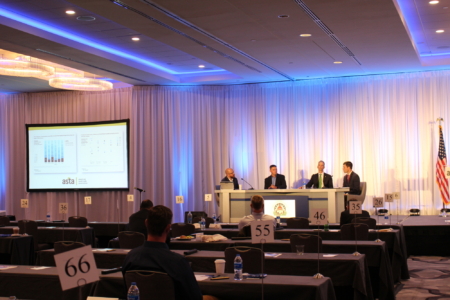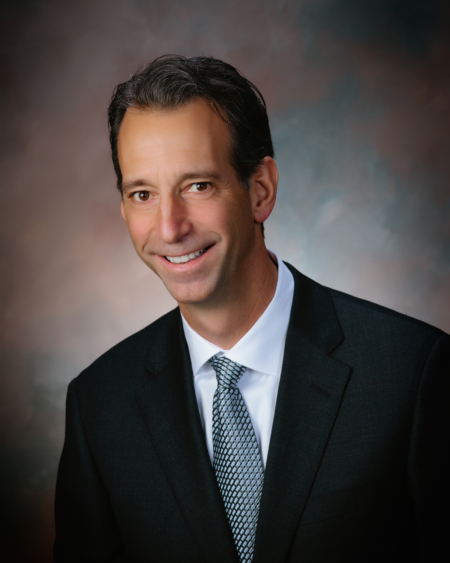
The panel on stage included, from left, Jake Ware, Dan Foor, Mike Gumina, and Andrew Lauver. John Chism joined the discussion remotely. (ASTA photo)
Washington, DC (June 21, 2021) - As seed companies start to look past the COVID-19 pandemic, they’re left to consider what changes will remain in place and for how long.
A panel discussed the situation June 21 during the American Seed Trade Association (ASTA) Policy & Leadership Development Conference (PLDC) in Washington, DC.
The panel included Andrew Lauver of Syngenta, John Chism of Corteva Agriscience, Dan Foor of La Crosse Seed, and Mike Gumina of RiceTec.

Jake Ware
“There’s no question the landscape of work has hugely been impacted by the pandemic,” says moderator Jake Ware, HM.Clause business manager. “We have all had to quickly adapt to new ways of getting work done. Many companies transitioned to a fully remote format.”
With restrictions mostly lifted across the country, Ware says companies are considering what the new office space will look like and leaders are wondering how to adapt to it. The issues are timely and not ones that are easily solved, he adds.
The Future of Remote Work
The panel was asked to discuss several articles that have been written about the topic, including “What employees are saying about the future of remote work” published April 1 by McKinsey & Company.
Ware says the results of the surveys in the article showed results prior to and after the pandemic. It shows the level of anxiety about the transition and changes and how worker productivity is affected by remote working.
He says prior to the pandemic, 25% of workers wanted a flexible schedule to be able to work remotely. Post-pandemic, Ware notes that number jumps to 52%. Many workers are serious about the issue, with 30% globally and 28% within the United States saying they’re likely to leave their job if not offered a flexible schedule.
Remote working is defined as three or more days working from home.
Experiences in the Seed Industry

John Chism
The statistics are consistent with what has been found through surveys of employees at Corteva, says Chism, a customer service and sales support leader.
“We’ve all been evolving,” Chism says. “It’s going to be really important to continue to have an open mind and continually evaluate the situation as we go through the rest of this year and into future years. We’re all working from new paradigms. We are all learning together.”

Mike Gumina
However, for many companies such as RiceTec, Gumina says most employees are not in a position to be able to work remotely.
“In our industry, particularly our company, 80% of people don’t have these choices,” says Gumina, RiceTec’s Global CEO. “Most of our people are on the front lines. It requires them to be on site. Even through the pandemic, most of us can say that most of our workforce was there full-time.”
Gumina adds only a small percentage, about 20%, have the luxury to think about working remotely.
“Within that group, there are some people who strongly desire to have a flexible work arrangement,” he says. “There are others who absolutely want to get back to the office space. There are reasons on both sides of that.”
Gumina says from his perspective, not being in the office comes down to the collaboration factor.
“It’s one thing to be active and doing your job,” he explains. “But you miss those moments where you can in an ad-hoc way talk to other people, share ideas, get support, or give support. I think that’s what people feel like they’re missing. It gets down to personal choices.”

Andrew Lauver
Lauver, a sales representative for Syngenta, says he has seen a transformation of how businesses operate, and some employees are feeling anxiety as a result.
“Conversations aren’t happening that need to be happening between a manager and an employee,” Lauver says.
Lauver says it’s important to find a balance between family and work life.
Ware adds that remote working can be done, but it needs to be done in a way that is successful for everybody.
“With the pandemic a lot of people were thrown into working at their house and they didn’t have a design or plan,” Ware says. “You’ve really got to push through and figure that out. Remote working can be done, but it’s got to be done well.”

Dan Foor
Foor, the CEO of La Crosse Seed, says he’s had similar experiences trying to figure out which employees can successfully work from home. The changes started suddenly, Foor says, as he will never forget March 13, 2020.
“That’s when the world flipped upside down,” he says.
Foor explains he and the company controller were scrambling by going to electronic stores trying to find laptops for the customer service to be able to work from home. He felt his anxiety was at the highest level it’s ever been in business.
“A lot of that was dealing with the unknown,” Foor says.
He notes there were some challenges along the way as a result of having members of the team in different places and figuring out who should be what such as answering the phones.
“We’re in a very seasonal business,” Foor says. “COVID last year happened at the exact worst time that it could have ever happened for the seed business. You scramble any way to make things happen, and then throw that on top of it.”
Foor says the company has tried to find the right balance for employees, and he says they’ve been successful in retaining employees by being as flexible as possible.
“We’re fairly well protected from that,” Foor says. “We have always been a flexible company that tries to accommodate the needs of our people. What we saw was actually a desire for folks to come back because they missed that sense of community.”
A Hybrid Approach
Foor points out some employees have opted for a hybrid approach, which is something he sees in some situations continuing as necessary.
Gumina suggests having a decision aid, which helps to evaluate whether somebody is in a position to work remotely. He says the criteria that RiceTec uses includes whether the employee is in a position to touch products and interact with customers; whether that person is competent, well-trained, and has the support system allowing them to work independently; whether the infrastructure is in place with the equipment and bandwidth to allow them to stay connected; and whether their manager can help them be successful.
“All those things have to come together,” Gumina says. “It’s given our managers the tools and freedom to work through this with each one of our people that have been working remotely that we either will or will not have come back into the office or work into some sort of hybrid situation.”
Chism says companies will continue to evaluate what needs to be done in terms of workspace setup.
“We’re all going to be on a pretty steep learning curve for some time to come,” Chism says. “This is certainly a space where one size does not fit all. I know that makes it more challenging to manage, but as employers and an industry, we’re going to have to wrap our head around that because it is dynamic and differential.”
Gumina says the changes for employees in the workplace are situational.
“It’s less of a shift that’s being forced, but more of a realization,” Gumina says. “There are some roles that can be completely effective in a remote situation. That model in certain situations can certainly be extended.”
Written by Chris Lusvardi, Seed Today editor
Related Articles
- ASTA Members Advocating For The Seed Industry During Policy & Leadership Development Conference In Washington, DC 6/21
- ASTA Presents Distinguished Service Awards To Chet Boruff and Barb Glenn 6/22
- ASTA Announces New Leadership Team and National Award Recipients 6/23
- Panel During The ISF Virtual Congress Discusses What The Seed Industry Has Learned From The COVID-19 Pandemic 7/06
